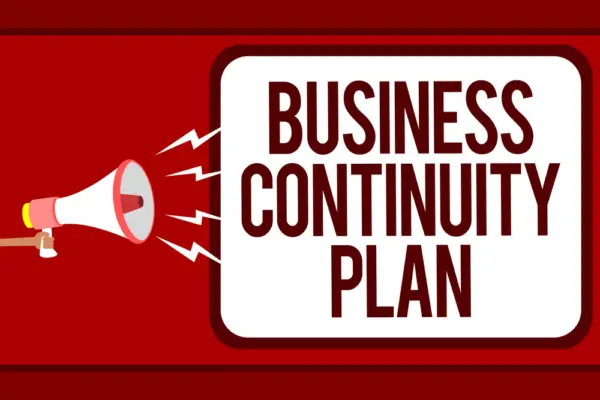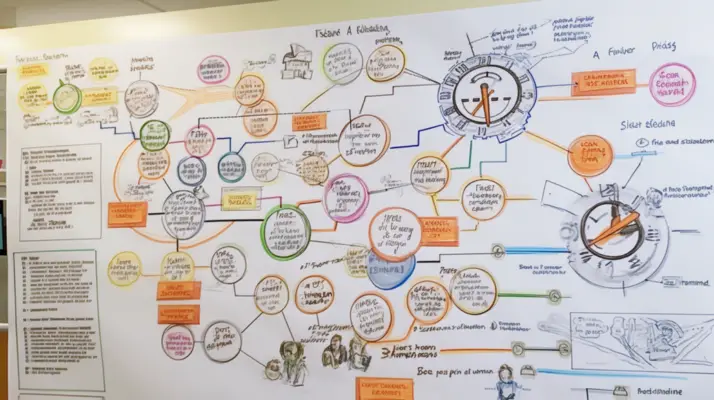Creating an effective Business Continuity Plan (BCP) involves several best practices that ensure your business can maintain operations during and after a crisis. Here are some key steps to follow:
- Assess Risks and Identify Critical Functions: Conduct a thorough risk assessment to understand the potential threats to your business operations and identify critical business functions. Knowing what processes are essential to your company’s survival is a foundational step in business continuity planning (Zerto).
- Establish Roles and Responsibilities: Clearly define the roles and responsibilities within your BCP. This ensures that staff members know what is expected of them and how to act in the event of a disruption (phoenixNAP).
- Develop Response Procedures: Your BCP should detail the procedures for responding to different types of disruptions, whether they are natural disasters, cyber-attacks, or any other crises that could impact your operations (phoenixNAP).
- Plan for Communication: Establish a communication plan that includes how to notify employees, customers, suppliers, and other stakeholders during a crisis. Effective communication is critical for managing expectations and maintaining trust (Amaxra).
- Regularly Review and Update the Plan: The business environment and potential threats are always changing. Regularly reviewing and updating your BCP ensures it remains current and effective (Diligent).
- Test and Exercise the Plan: Regular testing and exercises of your BCP are crucial to identify any weaknesses and to ensure that everyone knows what to do in an actual event. This can help to minimize the impact of disruptions when they occur (OdysseyIS).
A business continuity plan (BCP) is a comprehensive approach that ensures an organization’s critical functions remain available in the event of significant disruptions, ranging from natural disasters to cyberattacks.
It’s more than just a reactive measure; a well-constructed BCP is insurance for an organization’s sustainability, and its importance cannot be overstated.
Effective planning identifies potential threats, prepares protocols to address them, and outlines a clear path to restoring normal operations post-disruption.

Developing a successful BCP requires a detailed understanding of the business operations, identifying necessary resources, and allocating responsibilities.
Additionally, training and communication are pivotal in ensuring that all organization members understand the plan and their roles within it.
Regular testing and maintenance of the plan are necessary to address evolving challenges, ensuring the organization is always prepared. Furthermore, continuous assessment and improvement are crucial as they help to fine-tune the BCP to align with current risks and organizational changes.
Key Takeaways
- A well-prepared BCP is crucial for the resilience of an organization’s operations.
- Continual training and communication within the organization are vital components of an effective BCP.
- Regular testing, updates, and assessments of the BCP ensure it remains robust and responsive to new threats.
Understanding Business Continuity
Business continuity encompasses planning and preparation to ensure that an organization can continue operating in case of serious incidents or disasters and recover to an operational state within a reasonably short period.
This concept involves a mindset of resilience and an understanding of the essential components that keep a business’s core functions alive.
Business continuity planning is an essential process that enables organizations to maintain operations during and after a critical event.
The best practices for developing a robust business continuity plan (BCP) involve several key steps that ensure organizations can respond effectively to disruptions and minimize their impact on operations. Here, we delve into these best practices, providing a roadmap for uninterrupted operations.
Risk Assessment and Business Impact Analysis
A foundational step in business continuity planning is conducting a thorough risk assessment and business impact analysis (BIA).
This process involves identifying potential threats to the organization, such as natural disasters, cyber-attacks, or supply chain disruptions, and evaluating their likelihood and potential impact on business operations.
By understanding the risks, businesses can prioritize their planning efforts towards the most significant threats, ensuring that resources are allocated effectively to mitigate risks.
Identifying Critical Functions and Resources
Once the risks are understood, the next step is to identify critical business functions and the resources required to support them. This includes everything from key personnel and technology to data and supply chain components.
Understanding what is critical to maintaining operations allows businesses to focus their continuity efforts on ensuring these elements can withstand or quickly recover from a disruption.
Developing and Implementing Recovery Strategies
With critical functions identified, organizations must develop strategies to recover operations in the event of a disruption. This involves setting recovery time objectives (RTOs) for each critical function, which define the maximum acceptable downtime.
Recovery strategies may include diversifying supply chains, implementing data backup and recovery solutions, and establishing alternative work arrangements for employees. The goal is to have actionable plans in place that can be quickly executed to restore operations to an acceptable level.
Communication and Training
Effective communication and training are pivotal to the success of a business continuity plan. Organizations must ensure that all stakeholders, including employees, suppliers, and customers, are aware of the plan and understand their roles and responsibilities within it.
Regular training sessions and drills should be conducted to ensure that everyone is prepared to act according to the plan during an actual event. Clear communication channels should also be established to facilitate the flow of information during a disruption.
Regular Testing and Plan Maintenance
A business continuity plan is not a static document; it requires regular testing and maintenance to ensure its effectiveness.
Regular drills and exercises should be conducted to test the plan’s components and identify any gaps or areas for improvement.
Additionally, the plan should be reviewed and updated regularly to reflect any changes in the business environment, such as new risks, changes in business operations, or technological advancements. This iterative process ensures that the plan remains relevant and effective over time.
Fundamentals of Business Continuity
Central to business continuity is the identification of an organization’s key products and services and the most urgent activities that are necessary to keep these elements functioning.
It is crucial for businesses to conduct a Business Impact Analysis (BIA) to classify these essential components and to determine the resources required to support them during an adverse event. This analysis will typically outline the following:
- Critical business functions.
- Dependencies between various business areas and functions.
- The potential impact of business disruptions.
Risk assessment is also vital, involving identifying risks that could lead to disruptions and evaluating them in terms of likelihood and impact.

The Importance of Resilience
Resilience in business continuity refers to an organization’s ability to resist, absorb, and recover from the effects of an adverse event in a timely and efficient manner.
This resilience pertains to restoring business operations and the capability to adapt and evolve in the face of future disruptions.
An organization’s resilience is enhanced by a comprehensive business continuity plan (BCP), which sets out the processes and procedures required to maintain and restore business operations.
Distinguishing Between BCP and DRP
While often mentioned together, business continuity planning (BCP) and disaster recovery planning (DRP) differ in focus and scope. Business continuity planning is a proactive plan encompassing the management oversight, planning, and actions that are necessary to minimize disruption and ensure continuity of operation for the entirety of the business.
Conversely, a disaster recovery plan is typically a subset of business continuity planning and focuses on recovering specific operations, systems, and data after a disaster. In short, BCP is about keeping operations going, while DRP is about recovery after cessation of normal operations.
Planning and Strategy
An effective business continuity plan hinges on thorough planning and a strategic approach. Businesses must understand the potential impacts of disruptions and assess risks to develop resilient strategies.
This essential planning and strategy foundation is composed of a business impact analysis, comprehensive risk assessment, and the development of robust recovery plans.
Conducting a Business Impact Analysis
A Business Impact Analysis (BIA) identifies critical business functions and quantifies the effect of their disruption. It prioritizes services and products, considering both short-term and long-term impacts.
To formulate a solid business continuity strategy, organizations must use the BIA to guide resource allocation during recovery.
| Step | Action |
|---|---|
| 1 | Identify critical business functions. |
| 2 | Assess the qualitative and quantitative impacts of disruptions. |
| 3 | Determine the maximum allowable downtime for each function. |
Risk Assessment Procedures
Risk Assessment is a thorough examination of potential threats and vulnerabilities that could interrupt business operations.
Companies must evaluate the likelihood and consequence of diverse risks, including natural disasters, cyberattacks, and market changes. Risk assessment informs the preparation of responsive measures for potential business disruptions.
- Identify potential risks: What events could disrupt operations?
- Analyze vulnerabilities: Which areas of the business are most susceptible?
- Evaluate risk: How likely will a risk occur, and what would the impact be?
Developing Effective Plans
Developing effective plans involves creating actionable steps to implement during a disruption rapidly. These plans must be practical, encompassing recovery strategies for critical operations prioritized during the BIA.
An effective business continuity plan should include clearly outlined roles and responsibilities, steps for communication, and restoration processes.
- Outline recovery strategies: What are the steps to recover each critical function?
- Define roles and responsibilities: Who does what during a disruption?
- Communicate the plan: How will information be shared before, during, and after an incident?
Implementation and Operation
Implementing and operating a business continuity plan involves a structured approach where key business processes are identified, resources and roles are properly allocated, and IT infrastructure is considered to ensure resilience and readiness for any disruptions.
Establishing Key Business Processes
Key business processes must be established by meticulously identifying and prioritizing the operations critical to the organization’s survival.
This step ensures that efforts are concentrated on maintaining continuity in areas where disruption would have the most severe impact.
Mapping these processes helps stakeholders understand the operational workflow and the interdependencies within the organization.

Allocating Resources and Roles
Once the critical processes have been identified, the next step involves allocating resources and defining roles effectively.
This ensures that each element of the business continuity plan has an owner responsible for its implementation and maintenance. Assigning responsibilities clearly is important to avoid confusion during a disruptive event.
Resources must include physical assets and personnel, making sure they are available to support the business continuity plan when required.
- Physical resources may include facilities, equipment, and technology.
- Human resources employees will execute the plan, requiring training to fulfill their designated roles.
IT Infrastructure Considerations
The IT infrastructure plays a pivotal role in modern organizations, and its resilience is critical for sustaining business operations. The business continuity plan should include:
- An inventory of hardware and software assets.
- A disaster recovery plan that outlines procedures for data backup, system restoration, and maintaining cybersecurity in the event of an incident.
- A definition of the acceptable downtime for each system, aligning with the recovery time objectives that minimize operational impact.
Testing and updating these IT considerations regularly is crucial, as they can change with the evolving technology landscape and potential new threats to the organization’s IT systems.

Chris Ekai is a Risk Management expert with over 10 years of experience in the field. He has a Master’s(MSc) degree in Risk Management from University of Portsmouth and is a CPA and Finance professional. He currently works as a Content Manager at Risk Publishing, writing about Enterprise Risk Management, Business Continuity Management and Project Management.


